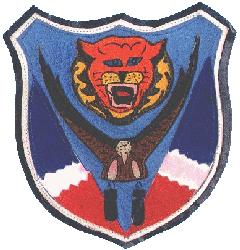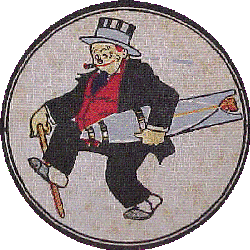The history of the 11th Bombardment Squadron begins June 26, 1917, when it was organized at Kelly Field, Texas, under the designation of the 11th Aero Squadron. The Squadron served overseas in the first World War from December 17, 1917, to May 1, 1919. It participated in four major battles. George McManus, famous creator of 'Jiggs' comic strip, was a member of the unit and the designer of the Squadron insignia, which shows Jiggs hustling along with a bomb under one arm and an expression indicating fine plans of mischief afoot for someone.
The 11th Bombardment Squadron has a long, rich history, both before and after World War II. However, we will generally only address the WWII portion on this page.
- Organized as 11th Aero Squadron 26 June 1917
- Redesignated 11th Squadron 14 March 1921
- Redesignated 11th Bombardment Squadron 25 January 1923
- Inactivated 31 July 1927
Constituted 11th Bombardment Squadron (Heavy), activated and assigned to 7th Bombardment Group at Hamilton Field, CA, 20 Oct 39, operating B-17s, the Squadron performed rescue and patrol duties from Fort Douglas, UT, c. 21 Jun - 13 Nov 41.
Following the bombing of Pearl Harbor the 11th performed anti-submarine patrols off the California coast, 8 - 11 Dec 41. Assigned to detached duty to USN at Brisbane, Australia, 22 Dec 41, the Squadron flew combat while operating from Hickam Field, HI, 18 Dec 41 - 5 Jan 42; Singarosi, Java, 13 - 19 Jan 42; Jogjakarta, Java, 19 Jan - 4 Mar 42; the Fiji Islands and Australia, 14 Feb - 4 Mar 42; and Melbourne, Australia, 4 Mar - 6 Apr 42.
Reassigned without personnel back to the States and redesignated "11th Bombardment Squadron (M)". Both the 11th and the 22nd were independent units during their organizational stages, ie. not assigned to any group but attached to 17th Bombardment Group, at Columbia AAB, SC for training, 26 Apr - 28 May 42. Cadre personnel were drawn from squadrons of the 17th Bomb Group and the 89th Reconnaissance Squadron. These same squadrons had also provided crews for the Doolittle Raid on Tokyo. With the cadre units in place, other personnel began to arrive from various parts of the U.S., by far the biggest contingent coming in from Keesler Field, Miss. The Squadron was officialy activated at Columbia, SC, on 3 May 1942.
While the build up was going on, an advance cadre of the Squadron were establishing the organization. They arrived at Karachi, India, 20 May 1942, working their way to their staging base at Allahabad, India, by 27 May, and on to Kunming, China by 14 June.
By mid-May the B-25s and crews of "Project 157" began to arrive from the U.S., and a few Dolittle Raiders also joined the Squadron. The Squadron had been assigned the task of supporting Gen Claire Chennault's forces... the American Volunteer Group (AVG) and the soon to be activated Chinese American Task Force (CATF). The prime responsibility for the 11th Squadron in China was the destruction of the enemy land transport system. Railyards and rolling stock was under almost constant attack by fighters and the B-25s of the 11th. The Squadron bombed bridges, locomotives, railroad yards and other targets to delay movement of supplies to the Japanese troops driving against the Chinese forces, threatening to over run the entire country.
Additional ground crew personnel soon joined the Squadron, having sailed from Charleston on 28 May aboard the troop transport, SS Santa Maria. They had landed at Karachi, India on 23 July and were transported by motor vehicle to New Malir, which was referred to as an air base but was in reality a staging area. A small contingent of the 7th Bombardment Group (Heavy) was stationed at New Malir, with the main portion then in Australia, having evacuated the Phillippines earlier in the war. At that point both the 22nd and the 11th were assigned to the 7th Bombardment Group, with the unusual distinction of being medium squadrons assigned to a heavy group But this was merely for administrative purposes, not for operational assignments. These additional personnel had then been transported to join the remainder of the Squadron.
In September the 11th was assigned to the 341st Bombardment Group (M), which had just been formed, with administrative personnel pulled from both the 22nd and the 11th added to those transferred from the 7th Bomb Group. In October, 1942 the 11th was ordered to its new base at Chakulia in southern Bihar, 140 miles west of Calcutta. They were operating as part of the 341st Group, 10th Air Force, with the AF headquarters in New Delhi, India.
The newly born Fouteenth Air Force, including the 11th Bomb Squadron, was industriously engaged in denying the freedom of the China Seas from the enemy when the 341st Bomb Group was moved from Chakulia, India, with its 22nd and 491st Bomb Squadrons, to China, in January of 1944. And so, the 11th Squadron gained the help of her sister squadrons in maintaining the freedom of valiant China.
Later in the spring, they supported the offensive on the Salween front, attacking supply lines, bridges, and military areas in Thailand and along the Burma-China border. The remainder of 1944 and early 1945, saw the 11th tasked with interdicting the supply and transportation routes critical to the Japanese war machine. Along with 491st and the 22nd, Squadron aircrews perfected bridge busting with the 'glip' bombing technique. These and similar efforts continued through the remainder of the Japanese effort, and precluded the Chinese Offensive in the early summer. By late July 1945, the majority of the 11th's combat work was complete. In early August, combat operations all but ceased.
The squadron was 'transferred' to Camp Kilmer, NJ, and inactivated 1 - 2 Nov 45.
The 11th Bomb Squadron was reactivated and is currently operating B-52s with the2nd Bomb Wing at Barksdale Air Force Base, LA, under the 8th Air Force.
A great web site is maintained by John Mongell, son of an 11th Bomb Squadron veteran . Tribute to the Flying Tigers of the 14th Air Force Association
-
Commanders
- Major Gordon C. Leland -- On/about 5 May 42; KIA on 2 Jun 42
- Major William E. Bayse -- 3 Jun 42-31 Dec 42
- Capt. Everett Holstrom -- 1 Jan 43-25 May 43
- Maj. Allan P. Forsythe -- 26 May 43 - 31 Junl 43
- Lt.Col. Morris F. Taber -- 31 Jul 43 - 22 Nov 43
- Lt.Col. Joseph P. Wells -- 22 Nov 43 - 14 Apr 44
- Maj. Milton H. Hendrickson -- to assume Cmnd on 11 Jan 44, KIA on 0rientation mission 10 Jan;
- Capt. Theodore J. Michel -- 14 Apr 44 - 22 Oct 44
- Lt. Col Charles G. Willes -- 22 Oct 44 -
-
Stations
-
WW II Campaigns
- Anti-submarine, American Theater
- Philippine Islands
- East Indies
- Air Combat, Asiatic-Pacific Theater
- India-Burma
- Chinese Defensive
- New Guinea
- Central Burma
- China Offensive
-
WW II Decorations
- Distinguished Unit Citation
- Netherlands Indies, 14 Jan - 1 Mar 42
- French Indo China, 11 Dec 44 - 12 Mar 45
-
Aircraft Operated
- B-17, 1940 - 1942
- B-25, 1942 -1945
- B-26, 1945
-
PERSONNEL
Click here for a complete personnel roster of the 491st Bomb Squadron, 1942 - 1945.

